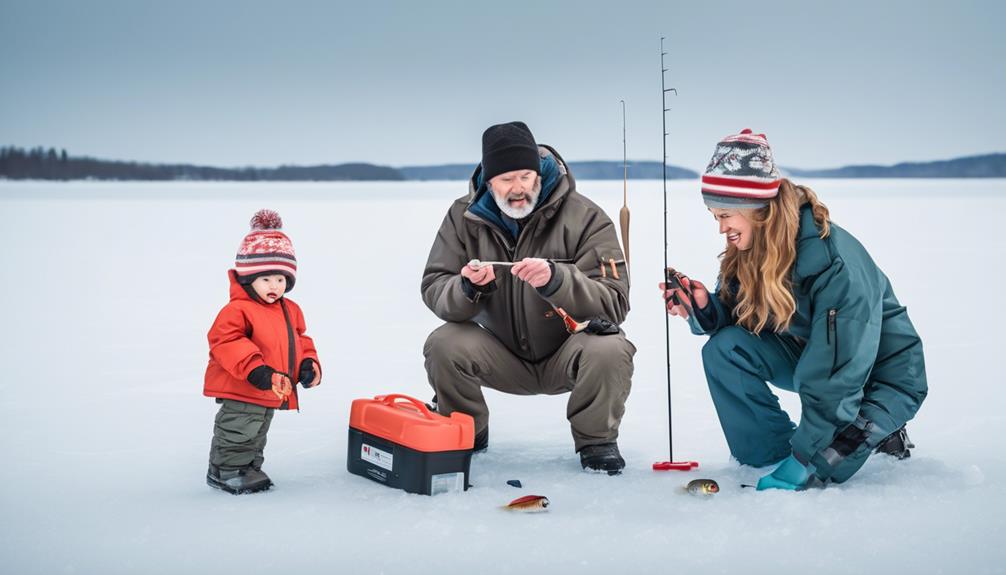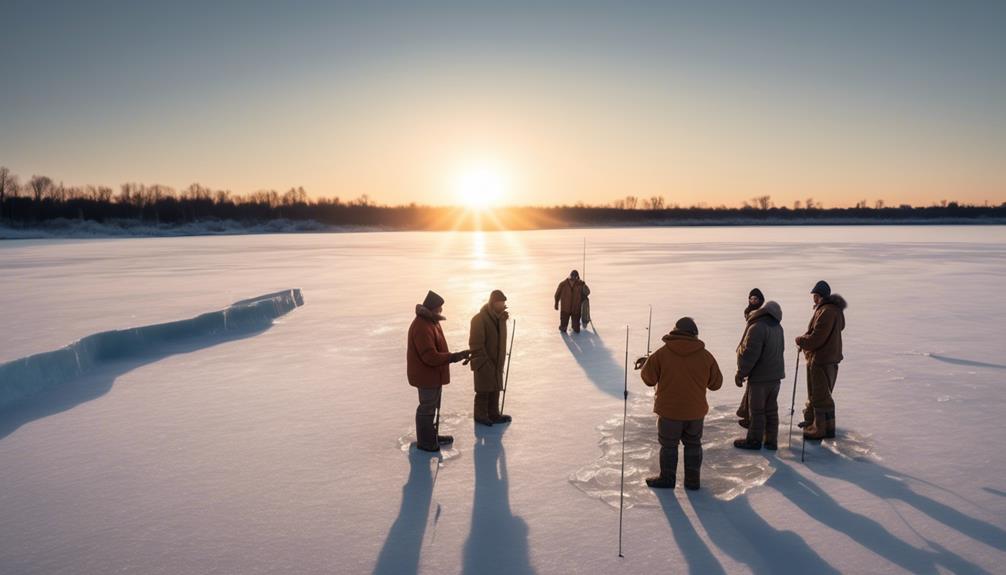When it comes to ice fishing, navigating the frozen surface is like walking on thin ice. As you set out with your family, ensuring everyone's safety becomes a top priority.
With the right knowledge and preparation, you can make the most of this unique outdoor adventure while keeping your loved ones safe. But how do you know if the ice is sturdy enough?
Let's explore some essential tips to help you enjoy a fun and secure ice fishing experience with your family.
Understanding Ice Safety
Before venturing onto frozen lakes or ponds for ice fishing, it's crucial to understand ice safety to ensure the well-being of your family.
One of the most important factors to consider is ice thickness. Always remember that the recommended minimum ice thickness for a single person is at least 4 inches. However, if you plan to take your family out on the ice, the thickness should be at least 5-7 inches. It's vital to check the ice thickness yourself using an ice auger and a tape measure. Don't rely solely on local reports or the observations of others.
Safety precautions should always be a top priority. Before stepping onto the ice, make sure to wear a personal flotation device (PFD) or a life jacket, especially for children. Additionally, carry ice picks, which can aid in pulling yourself out of the water if you were to fall through the ice. It's also essential to have a length of rope, a first aid kit, and a fully charged cell phone in case of emergencies.
Always inform someone of your plans, including your intended location and when you expect to return. Understanding ice safety and taking necessary precautions will help ensure a successful and safe ice fishing experience for your family.
Dressing for Cold Conditions
To ensure a comfortable and safe ice fishing experience for your family, dressing appropriately for cold conditions is essential. Layering clothing is crucial for staying warm in frigid temperatures. Start with a moisture-wicking base layer to keep sweat away from your skin, followed by an insulating layer such as fleece or wool to retain body heat, and finish with a waterproof and wind-resistant outer layer to protect against the elements. This method allows you to add or remove layers as needed, ensuring that you stay warm without overheating.
Proper footwear is vital when venturing onto the ice. Insulated, waterproof boots with good traction will keep your feet warm and dry while providing stability on slick surfaces. It's also advisable to bring along hand warmers to maintain dexterity and prevent frostbite. These small, disposable packets can be tucked into gloves or pockets to provide additional warmth for hours.
Remember that dressing for cold conditions isn't just about comfort – it's a safety concern. Hypothermia and frostbite are real risks when spending extended periods in freezing temperatures, so taking the time to properly layer your clothing, invest in quality footwear, and pack hand warmers can make all the difference in ensuring a pleasant and safe ice fishing outing for your family.
Choosing the Right Spot
When selecting a spot for ice fishing, consider the depth of the water and the presence of underwater structures that attract fish. Spot selection is crucial for a successful ice fishing experience.
Begin by checking the ice thickness. A minimum of 4 inches of clear, hard ice is generally safe for a single person, while 7-12 inches are needed for a small group. Always remember that ice thickness can vary, so use an ice auger to drill test holes as you move along.
Look for areas where the water is deeper as these tend to attract more fish, especially during the winter months. Deeper areas provide a more stable environment for fish and can offer a greater variety of species.
Additionally, underwater structures such as rock piles, fallen trees, or weed beds are prime spots for ice fishing as they act as natural habitats for fish. These structures provide shelter and food, making them hotspots for angling.
Keep an eye out for any visible signs of fish, such as holes in the ice or small cracks, as they may indicate fish activity below.
Equipment Checklist
Considering the crucial role of spot selection in successful ice fishing, it's essential to ensure you have the right equipment on your checklist before venturing onto the ice. Start with the ice auger selection, as it's crucial for boring holes in the ice. Hand augers are lightweight and portable, perfect for smaller holes, while power augers are more efficient for drilling larger holes.
Safety gear is non-negotiable. Every member of your family should have a properly fitting life jacket, ice picks, and a whistle in case of an emergency.
Next, an ice sled is a game-changer for transporting your gear across the ice. It's a convenient way to haul your auger, shelter, and other essentials without the hassle of carrying them all individually.
When it comes to the shelter, a portable option is ideal for family ice fishing trips. A pop-up shelter provides protection from the elements and can make your fishing experience much more comfortable. Look for one with insulation and built-in seating to keep everyone warm and cozy.
Additionally, don't forget about basic fishing equipment such as ice fishing rods, tackle, and bait. A sonar fish finder can also be handy for locating fish under the ice.
Lastly, pack some warm clothing, extra gloves, and hot beverages to keep everyone comfortable during your fishing adventure. With the right equipment checklist, you'll be well-prepared for a safe and enjoyable ice fishing trip with your family.
Basic Ice Fishing Techniques
Before heading out onto the ice for a day of fishing with your family, it's important to familiarize yourself with some basic ice fishing techniques. To ensure a safe and enjoyable experience, follow these essential tips:
Safety Precautions:
- Always check the thickness of the ice before venturing out. A minimum of 4 inches of clear, solid ice is generally considered safe for ice fishing.
- Wear appropriate clothing and gear for the cold weather, including insulated, waterproof boots, thermal layers, and a life jacket for added safety.
- Bring along safety equipment such as ice picks, a rope, and a first-aid kit. These items can be crucial in case of an emergency on the ice.
Proper Techniques:
- Drill your fishing holes using an ice auger, ensuring they're at least 6-8 inches in diameter. This allows for easy maneuvering and prevents the hole from freezing over quickly.
- Use a depth finder or a marked fishing line to determine the depth of the water and find the best spots for fishing.
- When fishing, try jigging the bait to attract fish. This involves gently jerking or moving the bait up and down to create a lifelike motion that entices fish to strike.
Family Communication Plan
After familiarizing yourself with basic ice fishing techniques, it's essential to establish a family communication plan for safety and coordination while out on the ice. Effective communication is crucial in ensuring everyone's well-being, especially in the event of an emergency.
Start by designating a meeting point on the ice where everyone can gather if needed. This spot should be easily identifiable and known to all family members. Additionally, equip each family member with a two-way radio or whistle to signal for help if they become separated from the group.
To further enhance family safety, contingency planning is essential. Before heading out onto the ice, discuss and agree on signals or calls that indicate danger or the need to regroup. It's also important to establish a clear plan for emergency response. Should someone fall through the ice or another emergency arises, ensure that everyone knows their role and responsibilities. Practice drills for various scenarios, such as how to assist someone who's fallen through the ice or how to navigate back to shore if disoriented.
Regularly review and update the family communication plan, ensuring that everyone is familiar with the procedures. Open and clear communication among family members will help mitigate potential risks and ensure a safe and enjoyable ice fishing experience for everyone.
Emergency Preparedness

To ensure the safety of your family during ice fishing expeditions, it's crucial to prioritize emergency preparedness. Being prepared for any unforeseen circumstances can make a significant difference in the outcome of your ice fishing trip. Here are some essential tips to help you stay safe and ready for emergencies:
- First Aid and Emergency Contacts: Pack a well-stocked first aid kit that includes adhesive bandages, gauze, antiseptic wipes, and any necessary medications. Additionally, ensure that you have a list of emergency contacts readily available, including local authorities, park rangers, and nearby medical facilities. In case of an emergency, having these contacts easily accessible can save precious time and provide the necessary assistance.
- Shelter: Carry a portable shelter such as a pop-up ice fishing tent or a thermal shelter. In case the weather takes a turn for the worse, having a shelter can provide protection from harsh winds and snow, keeping your family warm and dry. Additionally, pack extra blankets or sleeping bags to provide warmth and insulation within the shelter.
- Warmth Essentials: Dress in layers to maintain body heat and prevent hypothermia. Pack extra clothing, including waterproof outer layers, insulated gloves, hats, and waterproof boots. In the event of an unexpected extended stay on the ice, having these warmth essentials can make a significant difference in your comfort and safety.
Knowing When to Call It Quits
Prioritizing emergency preparedness is essential, but it's equally important to know when to call it quits and head back to safety during your ice fishing expedition. Recognizing warning signs is crucial for your safety. If you notice any cracks or sudden changes in the ice's appearance, it's time to leave. Additionally, if you observe water on the ice surface, it's a clear indication that it's time to pack up and head back. These warning signs should never be ignored.
When recognizing these warning signs, it's important to act swiftly and calmly. Don't wait until it's too late. It's crucial to have emergency procedures in place before heading out onto the ice. Make sure everyone in your group knows the plan in case of an emergency. This may include having a designated meeting point, emergency contact information, and a clear understanding of what to do in case someone falls through the ice.
Your safety should always be the top priority. Never hesitate to call it quits if you feel that the conditions are becoming unsafe. It's better to be cautious and head back to safety than to risk a dangerous situation.
Frequently Asked Questions
Can Children Under a Certain Age Go Ice Fishing With Their Family?
Yes, children under a certain age can go ice fishing with their family, but it's crucial to take safety precautions. Check the ice thickness, ensure appropriate age and outdoor gear, and always supervise them closely.
What Are Some Fun Activities for Kids to Do While Ice Fishing?
While ice fishing, kids can play ice fishing games, make winter crafts, and learn about ice fishing safety and outdoor education. It's a great way to have fun and stay safe on the ice!
How Do You Prevent Boredom During Long Hours of Ice Fishing?
To prevent boredom during long hours of ice fishing, try playing ice fishing games and getting creative with winter crafting. Share ice fishing stories and make it a fun family activity. Stay engaged and have a blast!
Are There Any Specific Regulations or Restrictions for Ice Fishing With a Family?
When ice fishing with your family, be aware of specific regulations and safety tips. Check local guidelines for ice fishing regulations and always prioritize safety. Ensure everyone has the proper gear and equipment for a fun and safe outing.
What Are Some Common Mistakes That Families Make When Ice Fishing Together?
When ice fishing with your family, common mistakes can include not following safety precautions, using improper equipment, and not having a plan for emergency response. Always be prepared and aware of potential dangers.
Conclusion
So, when you're out on the ice with your family, remember to prioritize safety. Dress warmly, bring the right equipment, and communicate effectively.
Keep an eye on the ice conditions and be prepared for emergencies. And most importantly, know when it's time to call it quits and head back to shore.
By following these tips, you can enjoy a fun and safe ice fishing experience with your loved ones.



